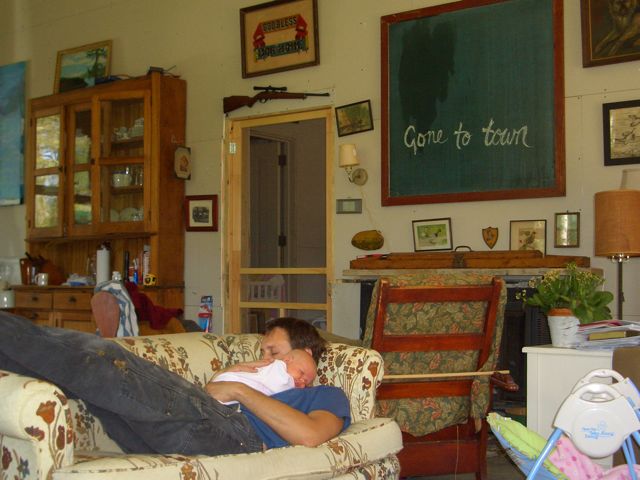Q&A with Artist Rob Fischer
Summer in Rob Fischer's Minnesota studio.
This interview was conducted using electronic mail. Questions composed by the Hammer’s new media manager Amanda Law. Look for information on Rob Fischer's Hammer Project here.
AL: Your usage of the gymnasium floor makes me want to know more about its specific history. Can you tell me about the history of the school it came from?
RF: When I was still in art school, I started driving and photographing things from the car as I was driving. I most often traveled north from Minneapolis, to the northern part of the state that I have always felt attracted to. After a few years of photographing, I realized that I was re-photographing the same small houses in different seasons. At one point I was way north, near the town where my grandfather grew up- Lancaster, Minnesota. He used to say that when their cows got out, he would have to cross into Canada to get them back- they were right on the border. So I drove into the tiny town, hoping I could find something about him. I found the tiny cemetery, then his one-room schoolhouse that they still used for town meetings. The door was unlocked, like everything in a place like this. It had two blackboards- one with “current” notes from the last town meeting (which might have been even a year earlier); the other had notes from returned alumni. These alumni notes in chalk included some from students in the twenties: “(person’s name), class of ’24, returned 1973”. No one had erased these notes that were written in 1973! The school was one room and had no gymnasium floor though.
AL: How did you come to salvage the flooring?
RF: I bought the floor from a company in Minnesota that salvages buildings. It was originally from a school in southern Minnesota. Pulling up a floor like that is a lot of work and I am glad I didn’t have to do it.
AL: How was the flooring that is on the Hammer lobby wall transported?
RF: The floor was taken apart completely and all the nails removed, so it could be transported on pallets. It is thicker than flooring is made now, and it is really heavy.
AL: Salvaging seems to be a theme for you. What is your studio like?
RF: I recently had to move studios. As with every studio I have ever had, once I fix it up enough, someone buys it and kicks me out. My last one had an outdoor area that I turned into a swamp, filled with my sculptures, and started to flood it. I was trying to get my sculptures to rot and grow new life. I got kicked out and that studio is now a youth hostel in Bushwick Brooklyn that looks like a fraternity party (complete with pool!). When I first got it, there were more rats than I have ever seen- you could see 40 or more at once, broad daylight. It took a lot to clean it out and get rid of the rats before I turned it into the swamp. I started shipping every old sculpture I had stored in Minnesota out to the Brooklyn swamp.
My new studio is much cleaner. So far. It is starting to fill up, but will likely be much less cluttered than the previous one. Lately I have felt better with clear space to look at new pieces in.
AL: What will happen to the flooring at the Hammer once your show closes?
RF: Only a sale keeps me from reworking a piece. Most of my work is “finished” then reworked, sometimes many times. Often after selling a piece, I want to rework it, so I will make a replica and cut that apart (I am doing that currently with a piece that the Corcoran museum just acquired).





